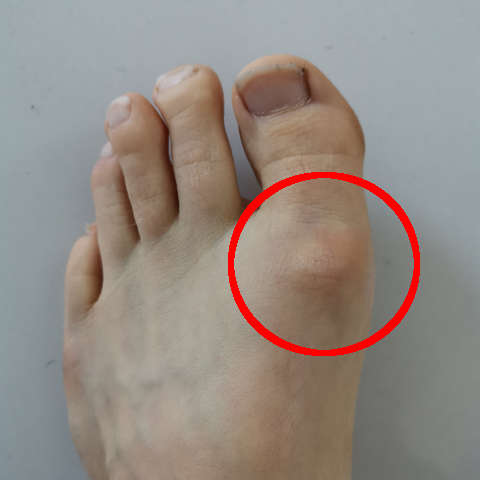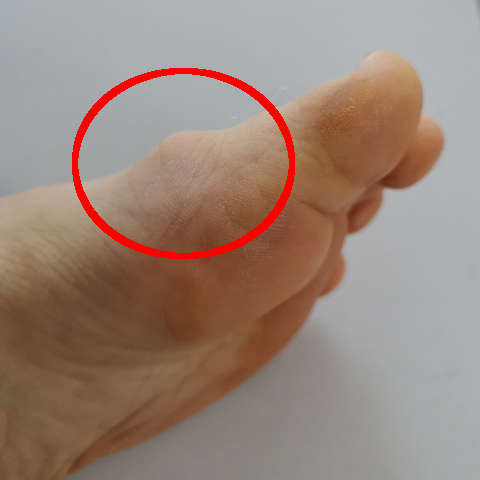Running pains and aches listed
During running, there's a huge amount of different pains that may be present. Some of them may occur only while running but may remain even afterwards.
The variety of aches is so huge that probably nobody knows all the details out there. I list my pains here, especially those I've had personally:
Knee pains
Knee pain, that only gets worse after every step. Eventually one must walk home without bending the sore foot. The very next day it's hard to drive the car as some knee bending is necessary. This was repeated every time while running. I was able to run at most just one mile. I learned to stop running quickly when the pain was starting up. At that time, I didn't really run, but rather, played floorball. During floorball I had no pain even when running quite a bit. Eventually I bought a knee support brace. It worked miraculously - while running with it, I had no more pain. Yet, the pains never come back. I used the brace at most ten times and no more needed it. I assume I had a minor misstep that the knee brace was able to correct.
Sudden knee pain during running, but from which complete recovery was possible during the run. I had to walk several times within the mile I was having the pain. Every time I thought the pain was gone, I tried to resume running - with no success. Usually I do some high knees for a few steps if I encounter some minor knee aches. This time that didn't work out at all. I tried different kinds of contacts on the ground and mimicking supination (lateral side hitting the ground first) eventually was the quick cure for the trouble. I was able to continue running for the rest of the 6 miles or so.
Swollen ankle
Swollen ankle on the inside whose cause was just a mystery. First I thought it was some kind of random hit I might've got while playing floorball or a sudden injury that went unnoticed. I kept an eye on the ankle and kept on running but slowly and carefully. While jogging at a slow pace it didn't really hurt that much. I assumed maybe the part that was broken didn't really participate in easy jogging. The swollen ankle lasted for a few weeks disappearing gradually. It was located at the ball joint of the ankle, making it look less like a ball.
Calf muscle cramp
A sudden calf muscle cramp during winter runs. This was happening one year quite rarely, but when it happened, it happened at the same location eg. after a mile. I was able to continue running, but I had to slow down quite a bit. The cramp itself was short in duration, lasting at most five minutes. I've no longer faced the issue except during some very hot summer nights - and even then, very rarely. I can only guess what's caused the cramps while running, but I'd point the finger at not-so-warm running pants. These days I wear really warm pants suitable for cold winter running. Hot summer night cramps might have been due to lack of sodium.
Hip area pains
Outside of hip / the upper thigh pain during running. I had to slow down dramatically for the rest of the run. After a week I tried to run a little faster but the sudden pain came back at the blink of an eye. The pain disappeared within three weeks. During that time, my runs were very slow, around 6:00 min / km,
First mile pains
Random aches in the beginning of the run are often present. It could be aches in the knee, feet, ankle or almost anywhere. The cause may depend on a number of factors, but the best thing with these is that they usually disappear within the first mile.
Achilles tendon pains
Achilles tendon is very sensitive. If it breaks apart it will need surgery and the recovery may be long. Fast intervals (with me, 3:30 min / km) with new shoes have been the most common cause for achilles tendon pains. Those have lasted only a few days so nothing very serious. Perhaps some patience is required with such new shoes that haven't been used before.
Lower butt pain on other buttock only
At times there's been short-lived but quite sharp pains on the other buttock, on the low outer side. First I had no cure for that other than slowing down. Over time, I learned that fixing the posture healed the problem instantly. During the long runs the posture may become poor thus provoking this kind of pain. It reminds us of the importance of proper running form.
Plantar fasciitis
It's possible to get plantar fasciitis via a number of ways. One of them is to use worn-out shoes. I had a pair of shoes I had run at least 1000 km (Nike Zoom Fly 3). I put one worn-out shoe on the other foot and a brand new shoe on the other. While standing, I didn't notice any differences between the shoes. The fact is that the shoes lose their functionalities over the miles. Perhaps the limit depends on the shoe and the runner.
Plantar fasciitis doesn't stop all runners. I have this problem as well. It hurts the most during the first mile of running, I don't really feel it while walking. Occasionally I've had to slow down remarkably or I've had to go heel striking when it felt very sharp and painful. Different kinds of ground contacts may ease the pain.
I was running with a pair of shoes that I've had at least 1000 km on. I guess that this was exactly the reason for getting this problem. There may be various causes and factors contributing to this. Also, high mileage (50-70, well high mileage for me) over a long period could be a factor as well.
Hallux Limitus - the big toe
Hallux Limitus limits the mobility of the big toe. It might cause a dorsal bunion as well. It may be seen on the images below:


I wasn't even aware of this pain, until I was wondering why Adidas Boston 8 shoes were causing pain exactly at the dorsal bunions. The tight fit of Boston shoes irritated the dorsal bunions. I read that high profile shoes might help. Low profile shoes like Adios and Boston provoked the pain even within a half marathon. This is not the complete truth, I'd suggest checking out the 'toe spring' of the shoes. By looking at the manufactures' pictures, you'd see Nike Pegasus (also Pegasus trail), and Zoom Air Tempo Next shoes have minimal 'toe spring' or the degree of upward curvature of the sole under the forefoot. Maybe the worst experience ever has been with Adidas Adizero Adios Pro 2 shoes. After the half-marathon race, both my big toes were sore for weeks afterward. It has a high toe spring, with very rigid material on the forefoot. That causes the toes to bend more than they'd ever need to.
This Hallux Limitus might go unnoticed. It could be that it never causes an issue. It's been told that it might propagate to the running form, making it less efficient. Alternatively, it might cause issues elsewhere in the body.
This Hallux Limitus doesn't go away itself but instead, it should get worse and worse. I read that some have run 16 years with this issue but still keep on running. So there's no reason to panic, but I'd suggest paying attention to the shoes. Get ones that have very limited toe spring, for example Nike Pegasus. I have Nike Air Zoo Tempo Next and Nike Pegasus Trail GTX shoes and love them both - they don't cause pains on my big toe joints.
Twitching all over body
So it happened that during the summer, after 2 days of a very hard run twitching started at night on one of my calf muscles. I was worried at first, thinking whether it might be a blood clot or something bad. Twitching remained for several days in the calf and started spreading to different muscles.
It spread to the eye, thighs, breast and all over the body within a month. I started to wonder if this is ALS as the muscles were so out of normal operation.
If ALS damages the spinal cord nerves, I thought that maybe the issue is involved with the nervous system. Eventually I found a cure that had an immediate effect: pulling the neck backwards. It could be that I've had laziness even with the running posture by not keeping my head pointing straight up.
The neck is not exactly pulled backwards, but the head and the neck should both go straight back, the opposite direction you're looking at. You should not bend the neck but move it back only. If you look at the mirror, you'd see your neck pointing straight up although it might not be possible initially. Usually the neck points up and leans forward a bit. This forward leaning may become excessive, causing problems in the nervous system. I learned the move 25 years ago when I was kickboxing. In addition to bending the head on the sides and looking on the sides (far left, far right) among other neck stretch moves, we also moved the neck straight back. The move healed the twitching immediately, but not for good. It took weeks before the issue was completely gone. Every day and even today I still pay attention to my neck. I may still feel occasional but very minimal twitching somewhere.
 On this juoksukengat.fi website we try to share the best possible advice about running ad related
material. We want to improve day by day, so we'd like to hear your feedback behind
this feedback form. Waiting for your feedback!
On this juoksukengat.fi website we try to share the best possible advice about running ad related
material. We want to improve day by day, so we'd like to hear your feedback behind
this feedback form. Waiting for your feedback!
Comments
We want to improve all the time and all comments are very welcome! Commenting requires Facebook login from the button below.